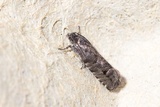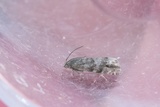Pammene splendidulana (Guenée, 1845) Species
Last modified: Nov. 25, 2025, 2:45 p.m.
A very rare species in Belgium.
Details
- Classification
- Family: Tortricidae > Subfamily: Olethreutinae > Tribus: Grapholitini > Genus: Pammene > Species: Pammene splendidulana
- Vernacular names
- Prachtdwergbladroller (NL), Drab Oak Piercer, Shining Oak Tortrix (EN), Eichen-Samenwickler (DE)
- Synonyms
- Pammene plumbatana (Lienig & Zeller, 1846)
- First mention in Belgium
- De Fré Ch. 1858. Catalogue des Microlépidoptères de la Belgique. — Annales de la Société entomologique belge 2: 45–162. On page 89.
- Status
-
Native
Distribution
Imago
Wingspan 10–12 mm. Brown forewings and head with the scales tipped, whitish ochre resulting in a dense irroration. One basal and a double one broad silver fascia centrally, replacing the common dorsal patch. One from the costa at two thirds that follows the basal edge of the ocellar area and is interrupted centrally by one or two black spots. There are a further three costal strigulae and there may be black ocellar marks.
Caterpillar
The caterpillar is white to pale green with black dots, the head, neck and anal shield are black.
Bionomics
The larva feeds between spun leaves on the host plant and feeds on the inner surfaces of the leaves, causing window-like patches but not eating the outer epidermis. When fully fed it spins a cocoon under bark, in rotten wood or in an old spongy oak-apple gall, including those which have fallen. It may pupate in autumn or overwinter as a larva.
The adults are on the wing from late afternoon into the evening and later come occasionally to light.
Flight periods
The adults have been seen from late March towards late May.
Observed on
- Host plant (genera):
- Quercus
The larva lives on Quercus robur and Quercus sp.
Habitat
It inhabits oak woods, gardens, parkland and mixed woodland where oak is plentiful.



